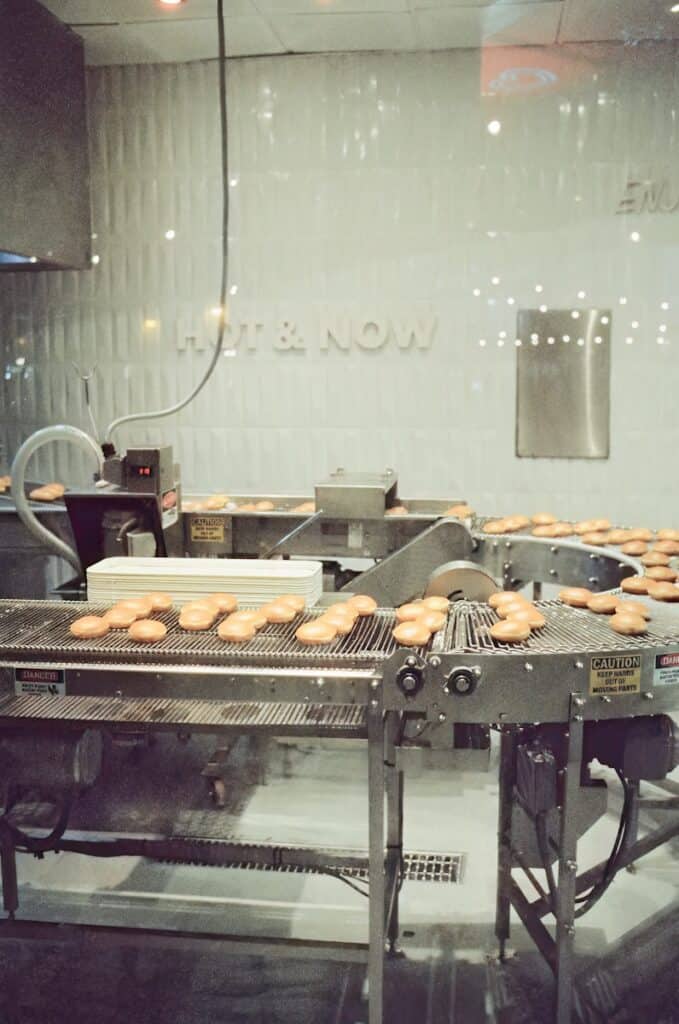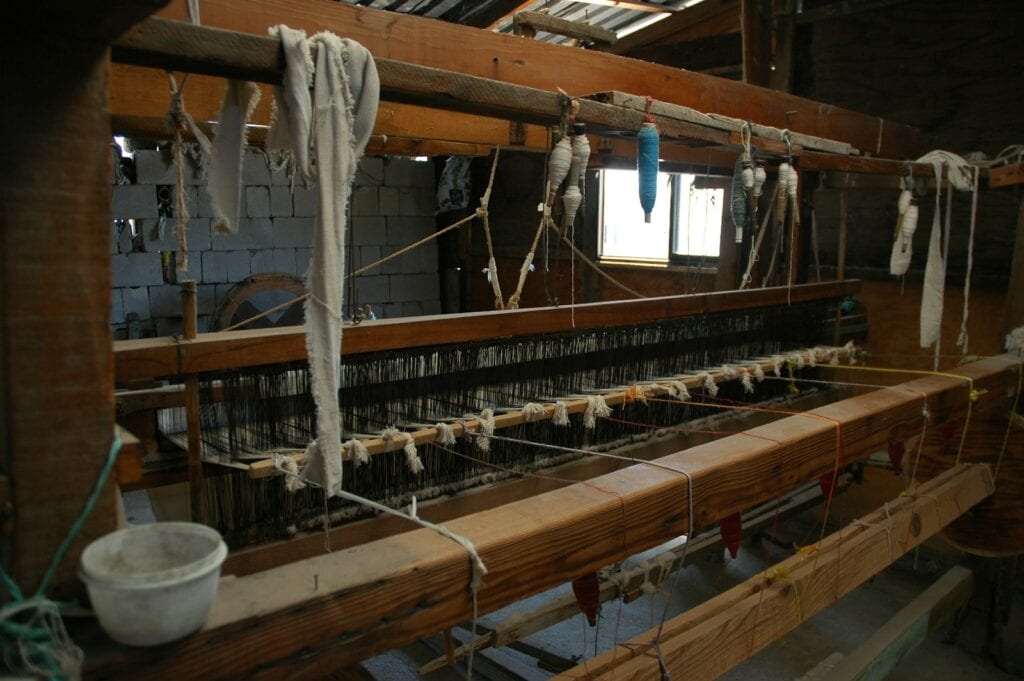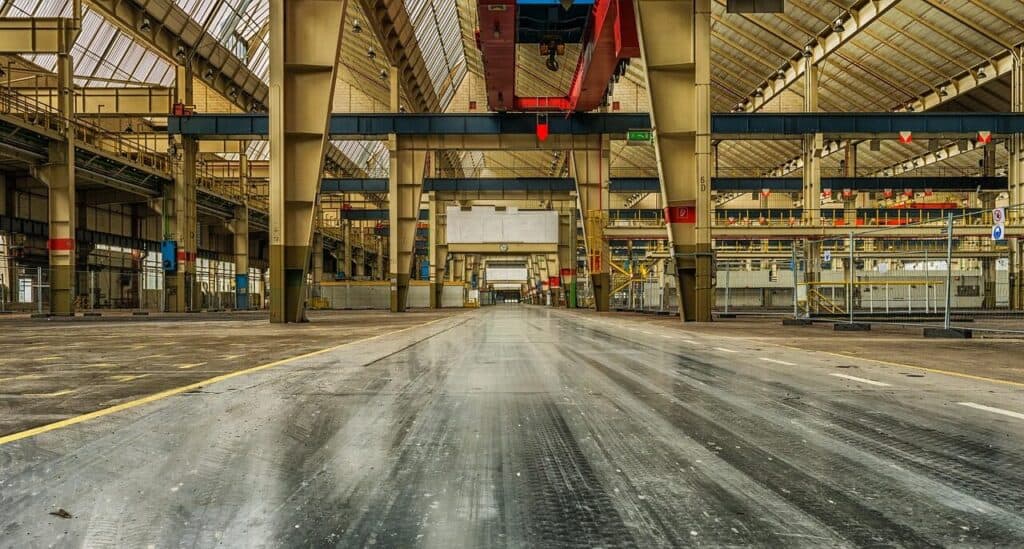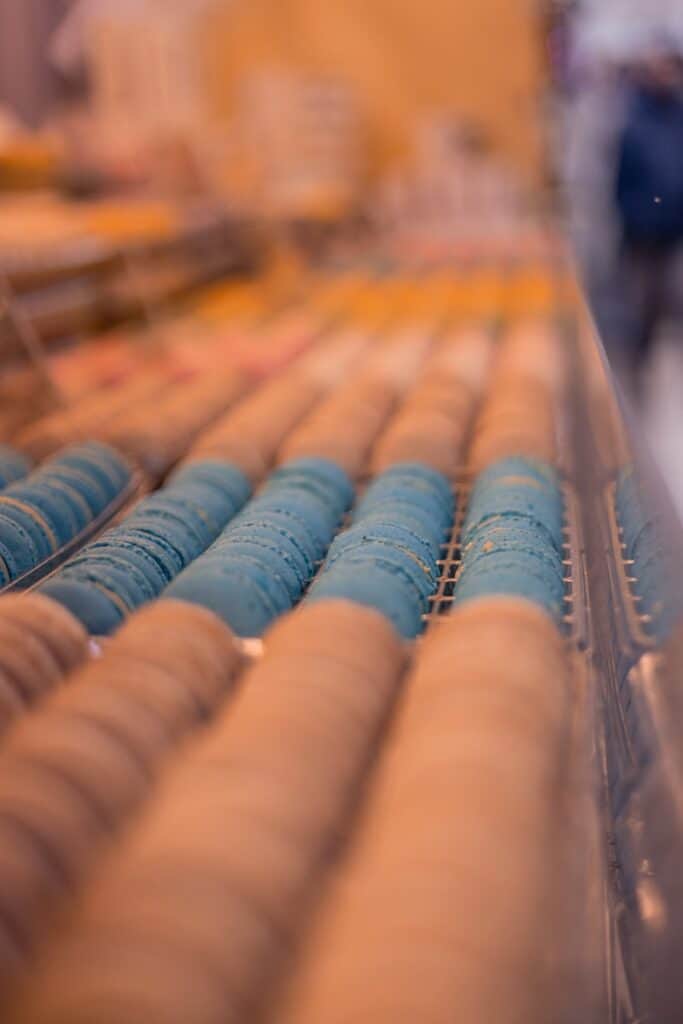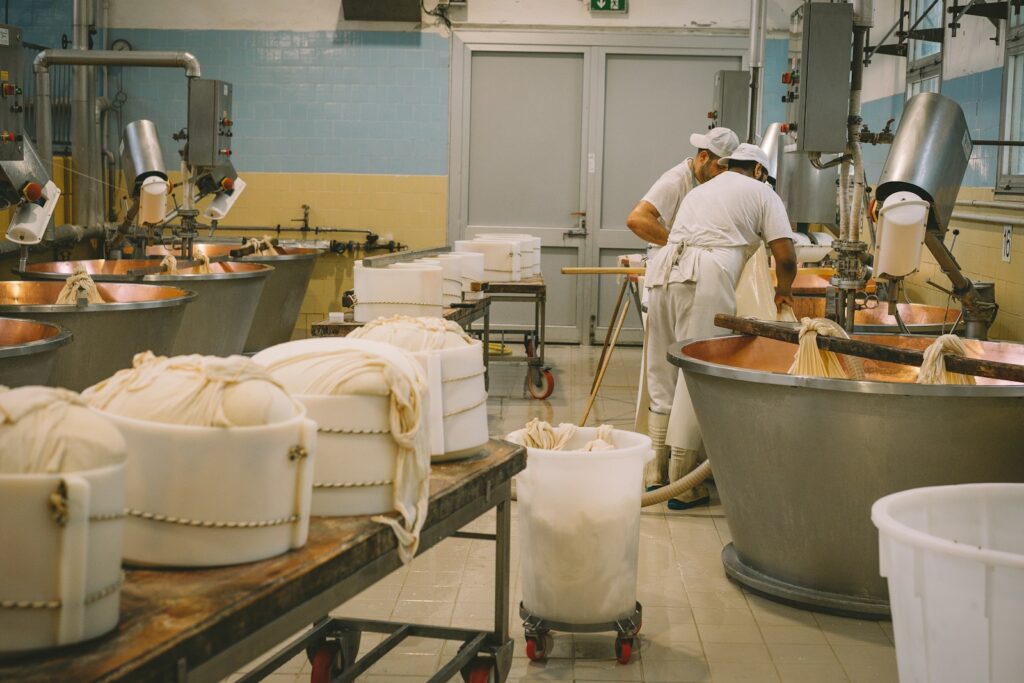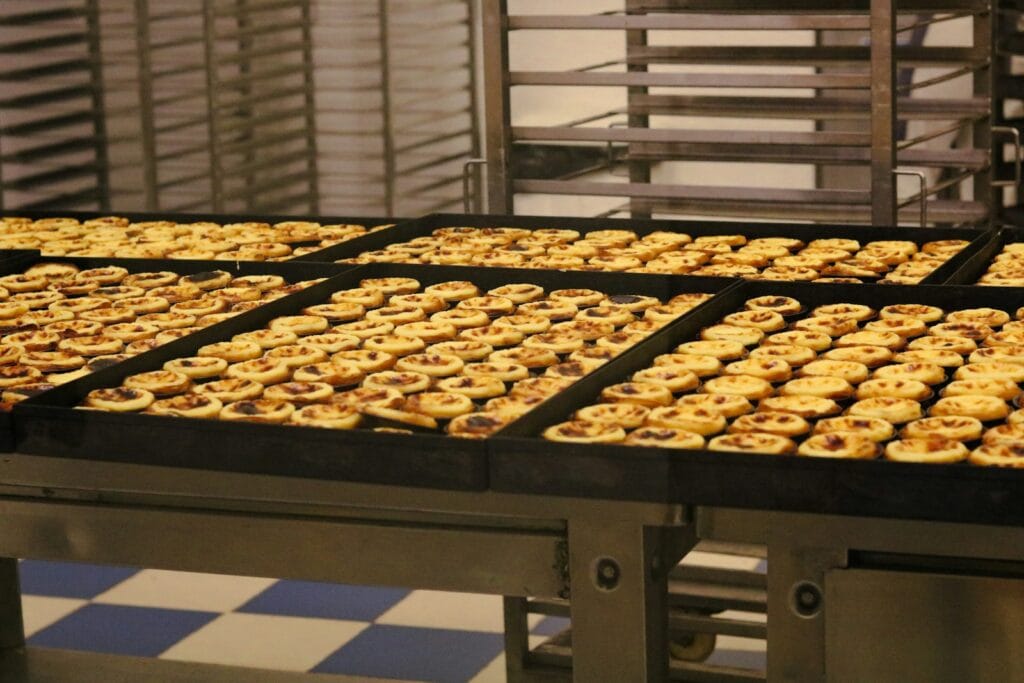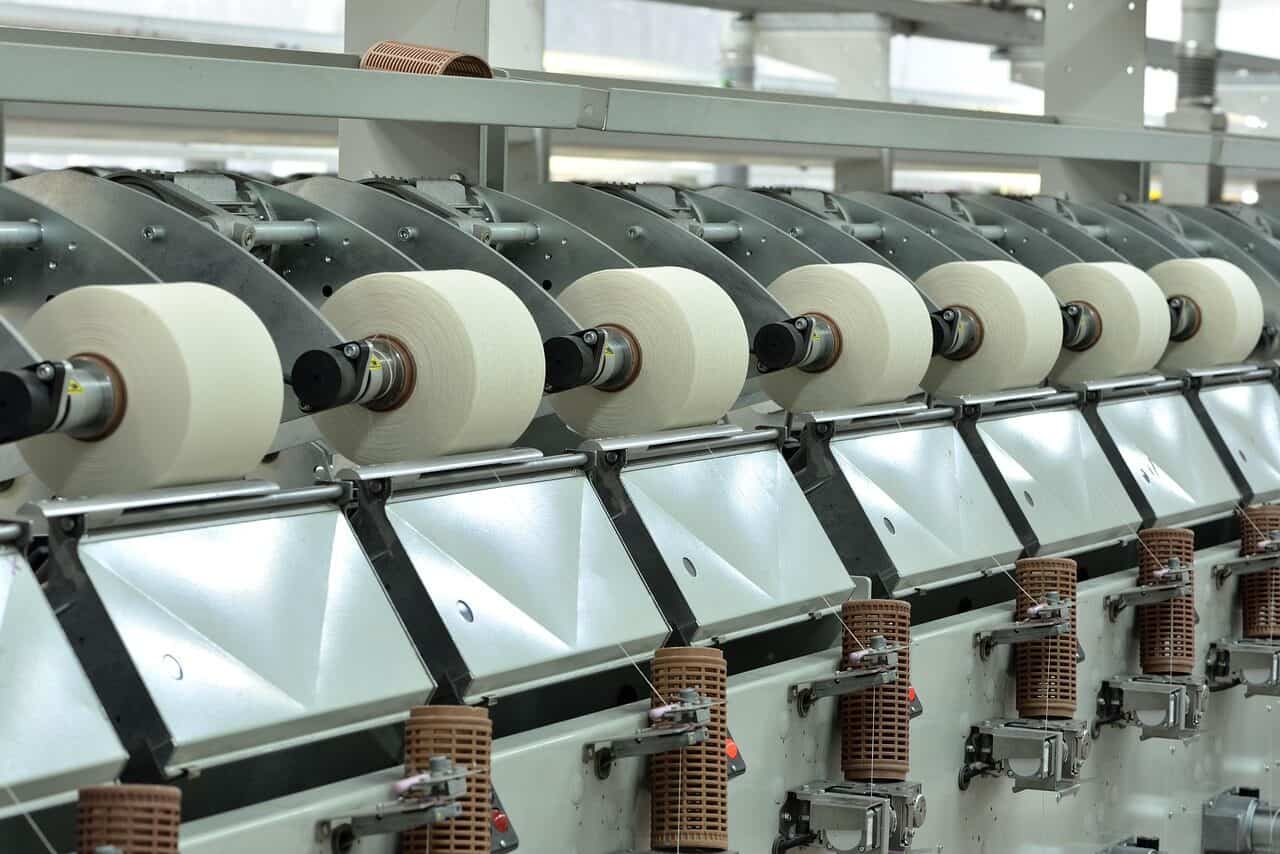Como funcionam as fábricas modernas de biscoitos: Um guia simples para fazer biscoitos e bolachas
Da padaria local às prateleiras dos supermercados, o simples biscoito passa por uma jornada incrível que está longe de ser simples. Por trás de cada biscoito ou bolacha com formato perfeito e assado de maneira uniforme está um exemplo incrível de engenharia moderna: a linha de produção de biscoitos. Os números são impressionantes - as grandes fábricas produzem milhões de biscoitos todos os dias. Não se trata apenas de assar; é uma fabricação de alta tecnologia.
Este artigo o levará a um tour completo por um moderno linha de produção de biscoitos. Analisaremos cada etapa do processo de fabricação de biscoitos, desde o armazenamento de ingredientes brutos até o encaixotamento de produtos acabados prontos para o envio. Examinaremos as máquinas importantes que fazem cada etapa funcionar e exploraremos as estratégias inteligentes usadas para fazer com que tudo funcione de forma mais rápida, suave e com melhor qualidade. Este é seu guia completo guia para entender como a produção industrial de biscoitos realmente funciona.
O que é uma fábrica de biscoitos moderna?
Em sua essência, um linha de produção de biscoitos é um sistema altamente conectado e automatizado de máquinas projetadas para transformar ingredientes crus em biscoitos acabados e embalados com pouquíssima ajuda humana. É um grande avanço em relação aos métodos tradicionais de cozimento, com foco na consistência, velocidade e produção em larga escala. Toda a operação se divide em uma série de estágios principais que fluem suavemente de um para o outro:
- Manuseio de ingredientes
- Mistura
- Formação
- Cozimento
- Resfriamento
- Embalagem
Embora as ideias básicas de panificação permaneçam as mesmas, os sistemas atuais de alto volume dependem de automação, controle computadorizado e eficiência incrível, permitindo que as fábricas produzam milhares de biscoitos por minuto.
O processo passo a passo
Preparando os ingredientes
É aqui que começam os produtos consistentes. Medidas precisas são absolutamente essenciais - mesmo pequenos erros nas quantidades dos ingredientes podem bagunçar a massa e arruinar a qualidade do produto final. Em uma fábrica moderna, esse processo é totalmente automatizado. Ingredientes grandes, como farinha e açúcar, são armazenados em enormes contêineres ao ar livre e transportados por meio de tubulações, usando a pressão do ar, para os compartimentos acima dos misturadores. Líquidos como água, óleos e xaropes são mantidos em tanques com temperatura controlada e medidos com medidores altamente precisos.
Antes de chegar ao misturador, os ingredientes secos geralmente passam por peneiras e separadores magnéticos para remover partículas indesejadas e tornar a farinha mais leve. Uma parte importante, mas frequentemente esquecida, é o controle de temperatura. A temperatura dos ingredientes, como a água e a gordura, afeta diretamente a temperatura final da massa, que controla o desenvolvimento do glúten e a facilidade de trabalhar com a massa. Sistemas de água gelada são comuns para garantir que a massa não fique muito quente durante o estágio de mistura de alta energia.
Fazendo a massa
O misturador é o coração da operação, onde os ingredientes separados se transformam em uma massa lisa e trabalhável. O tipo de misturador escolhido depende inteiramente do tipo de massa necessária para o produto final.
- Os misturadores de eixo vertical são geralmente usados para massas macias em que a adição de ar é importante.
- Os misturadores horizontais são os cavalos de batalha do setor. Os misturadores horizontais regulares funcionam para massas duras e semidoces, enquanto os misturadores de alta velocidade são essenciais para desenvolver a forte rede de glúten necessária para os biscoitos.
O processo de mistura equilibra cuidadosamente o tempo, a velocidade e a temperatura. Esses fatores determinam o grau de desenvolvimento do glúten. Para shortbread, é necessário misturar o mínimo possível para manter a textura "curta" e quebradiça. Para biscoitos, é necessário misturar bastante para desenvolver uma folha de glúten forte e elástica. Um problema comum na produção é a mistura incorreta - a massa misturada em excesso pode se tornar dura e difícil de trabalhar, enquanto a massa misturada em menor quantidade pode ser fraca e levar a formatos e texturas irregulares de biscoitos.
Moldando a massa
Essa etapa dá ao biscoito seu formato. O método usado depende da espessura ou da espessura da massa. Há três técnicas principais de modelagem em um linha de produção de biscoitos.
- Laminação e laminação: Esse método funciona para crackers e biscoitos de massa dura. A massa passa por uma série de rolos para formar uma folha fina e contínua. No caso dos biscoitos, essa folha pode ser "laminada", dobrando-a sobre si mesma várias vezes para criar camadas distintas de flocos. Em seguida, um cortador corta as formas finais da folha de massa antes de ela entrar no forno.
- Moldagem rotativa: Perfeito para massas macias e não elásticas, como shortcakes ou biscoitos para sanduíches. A massa é forçada em padrões esculpidos em um cilindro giratório. Um rolo revestido de borracha pressiona a folha de massa contra o molde, e os pedaços de massa moldados são removidos para a esteira do forno.
- Corte e depósito de arame: Esse é o método preferido para massas macias e com alto teor de gordura, como cookies. A massa é espremida por uma abertura moldada na esteira do forno e um arame ou lâmina em movimento corta cada pedaço com peso e formato consistentes. Os dosadores também podem ser usados para adicionar recheios ou criar formas complexas.
A etapa de cozimento
O cozimento é um processo complexo de transferência de calor e remoção controlada de umidade que define a estrutura, a cor e a textura final do biscoito. O cozimento industrial ocorre em fornos túnel enormes, que podem ter mais de 90 metros de comprimento. Esses fornos são normalmente divididos em várias "zonas de cozimento", cada uma com controles independentes de temperatura e umidade.
O tipo de forno utilizado depende do produto.
- Os fornos Direct Gas Fired (DGF), nos quais a chama está no mesmo espaço que o produto, fornecem calor intenso e direto, perfeito para desenvolver a estrutura dos crackers.
- Os fornos indiretos ou de convecção circulam o ar aquecido, proporcionando um cozimento mais suave, adequado para cookies delicados e biscoitos macios.
Esse controle baseado em zonas permite um cozimento preciso - por exemplo, uma zona inicial de alto calor para "levantar" rapidamente o biscoito, seguida por uma zona de temperatura mais baixa para secagem e uma zona final para dourar. O cozimento pode variar de 3 a 15 minutos a temperaturas entre 350°F e 540°F, dependendo do tipo de biscoito, do tamanho e do teor de umidade.
Resfriamento e empilhamento
O resfriamento controlado é tão importante quanto o cozimento. Quando os biscoitos saem do forno, eles ainda estão macios e contêm muito calor e vapor remanescentes. Eles passam para esteiras de resfriamento longas e de malha aberta que permitem que o ar flua livremente ao redor deles. Esse resfriamento deve ser gradual. Se os biscoitos forem resfriados muito rapidamente, pode ocorrer um problema chamado "checagem", em que as tensões internas causam o aparecimento de rachaduras finas na superfície horas ou até dias depois, levando à quebra.
Embora algumas linhas de produção usem resfriamento em temperatura ambiente, muitas usam túneis de resfriamento com ar forçado para melhor controle e processamento mais rápido. No final da esteira de resfriamento, que pode ter até 1,5 vez o comprimento do forno, os biscoitos estão firmes e estáveis. Em seguida, os sistemas de empilhamento automatizados organizam os biscoitos em pilhas organizadas em um número predeterminado, prontas para serem embaladas.
Embalagem
O estágio final do processo de fabricação de biscoitos é a embalagem. Isso protege o produto contra umidade e danos físicos enquanto o prepara para a venda na loja. A primeira etapa é o empacotamento primário, em que as empilhadeiras automatizadas de fluxo envolvem as pilhas de biscoitos em filme impresso. Essas máquinas trabalham em velocidades incríveis, embalando centenas de pacotes por minuto.
A partir daí, os pacotes embalados passam para os sistemas de embalagem secundária. Isso geralmente envolve braços robóticos ou sistemas mecânicos que colocam as embalagens em caixas, que são então seladas. Por fim, essas caixas são colocadas em caixas maiores, empilhadas em paletes por um robô e embaladas para envio. A automação de alta velocidade na embalagem é essencial para evitar que ela atrase todo o processo. linha de produção de biscoitos.
Melhorando a produção
Chaves para a eficiência
Obtendo o máximo desempenho de um linha de produção de biscoitos não é uma configuração única; é um processo contínuo de melhoria contínua. O objetivo é maximizar a produção e, ao mesmo tempo, minimizar o custo, o desperdício e o tempo de inatividade. Esse esforço é medido por números importantes, como a Eficácia Geral do Equipamento (OEE), que monitora a disponibilidade, o desempenho e a qualidade. Outros indicadores importantes são a taxa de produtividade (produto acabado por hora) e a porcentagem de desperdício. A verdadeira melhoria envolve uma análise profunda de cada processo, desde o uso de energia até a velocidade de troca.
Reduzindo o uso de energia
O forno consome a maior parte da energia da linha. A redução de suas necessidades de energia proporciona a maior economia de custos operacionais. As principais estratégias incluem:
- Melhor isolamento: A atualização do isolamento do forno com materiais avançados reduz a perda de calor para a área ao redor, mantendo o calor concentrado no produto.
- Sistemas de recuperação de calor: As chaminés de exaustão dos fornos liberam uma grande quantidade de ar de alta temperatura. Um sistema de recuperação de calor pode capturar esse calor residual e usá-lo para pré-aquecer o ar para os queimadores ou para aquecer a água para outros processos da fábrica, reduzindo significativamente o uso geral de gás.
- Queimadores melhores: A atualização de queimadores antigos para queimadores modernos e de alta eficiência com controle preciso da relação ar/combustível garante a queima completa e reduz o uso de combustível.
Tabela 1: Comparação de diferentes fornos de cozimento industriais
| Tipo de forno | Eficiência energética | Método de transferência de calor | Melhor para (tipos de biscoitos) | Principais considerações sobre otimização |
| Queima direta de gás (DGF) | Moderado | Convecção e radiação | Crackers, biscoitos duros | O ajuste do queimador e a manutenção regular são essenciais para a eficiência. |
| Convecção indireta | Alta | Convecção pura | Biscoitos de massa macia, cookies | Excelente controle de temperatura, mas requer ar limpo; otimize o fluxo de ar para assar uniformemente. |
| Híbrido (por exemplo, DGF + Convecção) | Muito alta | Combinação | Versátil para vários produtos | Custo inicial mais alto, mas oferece o melhor controle e eficiência por meio da transferência de calor específica da zona. |
Redução de resíduos
O desperdício prejudica diretamente a lucratividade. É fundamental uma abordagem sistemática para encontrar e eliminar as fontes de desperdício.
- Resíduos de massa: Nas operações de laminação e corte, a massa residual é criada nas bordas e entre as formas cortadas. Os sistemas modernos usam transportadores automatizados de retorno de massa residual que enviam essa massa diretamente de volta à laminadora para reutilização, reduzindo a perda de material.
- Redução de quebras: Os biscoitos são mais frágeis quando estão quentes. É extremamente importante melhorar os pontos de transferência entre a esteira do forno, as esteiras de resfriamento e os empilhadores. Até mesmo um leve desalinhamento ou uma queda de alguns milímetros pode causar uma quebra significativa. Certa vez, rastreamos as taxas de quebra em diferentes pontos de uma linha e descobrimos uma perda de 2% em uma única transferência de transportador. O realinhamento do transportador e a suavização da transição reduziram esse desperdício em mais de 80%.
- Desperdício de embalagens: O ajuste fino dos sensores e da mecânica das máquinas de empacotamento em fluxo pode reduzir o desperdício de filme decorrente de selagens incorretas ou atolamentos. Calibrar a máquina para usar o comprimento mínimo de filme necessário por pacote também pode gerar economias substanciais ao longo do tempo.
Melhoria dos tempos de troca
Em uma instalação que produz vários tipos de biscoitos na mesma linha, o tempo necessário para mudar de um produto para outro (tempo de troca) é um tempo de inatividade não produtivo. A aplicação de princípios de troca rápida é fundamental. O objetivo é converter o maior número possível de tarefas de troca em atividades que possam ser realizadas enquanto a linha ainda estiver em funcionamento.
As etapas práticas incluem:
- Kits pré-preparados: Ter os moldes do próximo produto, as matrizes de corte e quaisquer peças exclusivas da máquina limpas e prontas em um carrinho próximo à linha.
- Gerenciamento automatizado de receitas: Uso de um sistema de controle central para baixar automaticamente todas as configurações da máquina (velocidades do misturador, temperaturas do forno, configurações da empacotadora) para o próximo produto com um único comando.
- Sistemas de limpeza no local (CIP): A adição de sistemas de limpeza automatizados para misturadores, dosadores e sistemas de manuseio de líquidos reduz drasticamente o tempo e a mão de obra necessários para a limpeza entre lotes.
Tabela 2: Estrutura de retorno do investimento para atualizações da linha de produção
| Atualização de tecnologia | Custo inicial estimado | Melhoria do desempenho principal | Economia anual estimada | Período estimado de ROI |
| Sistema de recuperação de calor para forno | $50,000 – $150,000 | 10-15% Redução do consumo de gás | $20,000 – $40,000 | 2,5 a 4 anos |
| Empilhadeira automatizada | $30,000 – $80,000 | 2-3% redução da quebra pós-cozimento | $15,000 – $25,000 | 2 - 3,5 anos |
| Envolvedora de fluxo de alta velocidade | $80,000 – $200,000 | Aumento de 20% na velocidade de embalagem; redução de 0,5% de resíduos | $40,000 – $60,000 | 2 a 4 anos |
A revolução da fábrica inteligente
Além da automação simples
O processo moderno de fabricação de biscoitos está evoluindo além da simples mecanização para o reino da fábrica inteligente, ou Indústria 4.0. A diferença é a inteligência. Enquanto a automação básica envolve máquinas que executam tarefas repetitivas e pré-programadas, a automação inteligente envolve uma rede de sistemas que podem monitorar, analisar e até mesmo se autocorrigir. Os principais componentes dessa transformação são:
- PLC (Controladores Lógicos Programáveis): Os "cérebros" de máquinas individuais, controlando suas funções específicas.
- SCADA (Controle de supervisão e aquisição de dados): Um sistema que fica acima dos PLCs, fornecendo uma interface central para os operadores monitorarem e controlarem toda a linha.
- MES (Manufacturing Execution System, Sistema de Execução da Manufatura): Uma camada de software que conecta o chão de fábrica (SCADA) aos sistemas de planejamento da empresa, gerenciando programações de produção, receitas e dados de rastreamento.
Internet das coisas e análise de dados
O verdadeiro poder da fábrica inteligente vem dos dados. Isso é possível graças à Internet Industrial das Coisas (IIoT), uma rede de sensores colocados em toda a linha de produção de biscoitos. Esses sensores monitoram centenas de variáveis em tempo real: temperatura e espessura da massa, umidade do forno, teor de umidade do biscoito, cor e tamanho.
Esse fluxo constante de dados não é mais apenas para os operadores assistirem em uma tela; é para programas de computador avançados agirem.
- Manutenção preditiva: Ao analisar os dados de vibração e temperatura de um motor ou rolamento, um programa de computador pode prever sua provável falha com bastante antecedência. Isso permite que a manutenção seja programada durante o tempo de inatividade planejado, evitando falhas graves e paradas não planejadas dispendiosas.
- Autocorreção de processos: É aqui que a eficiência da automação dá um salto gigantesco. O sistema pode fechar o ciclo de feedback sem ajuda humana. Por exemplo, um sensor após o forno pode medir a cor de cada biscoito. Se eles começarem a ficar muito escuros, o sistema pode reduzir automaticamente a temperatura na zona final de cozimento em alguns graus, garantindo uma qualidade consistente o tempo todo.
Robótica e sistemas de visão
A robótica e a inteligência artificial estão revolucionando os estágios de produção que exigem muita mão de obra, principalmente no manuseio e no controle de qualidade.
- Robôs de coleta e colocação: Os robôs de alta velocidade agora são comumente usados para embalagem. Eles podem pegar delicadamente biscoitos delicados e colocá-los em bandejas ou caixas em velocidades muito superiores à capacidade humana, reduzindo os danos ao produto e melhorando a limpeza.
- Sistemas de visão alimentados por IA: São um divisor de águas para o controle de qualidade. Um sistema de câmera instalado sobre a esteira inspeciona 100% dos produtos que passam por baixo dela. Usando programas de IA, ele pode identificar instantaneamente e acionar um mecanismo de rejeição para qualquer biscoito que esteja quebrado, deformado, cozido demais ou de menos, ou que tenha a colocação incorreta da cobertura. Esse nível de inspeção é impossível de ser alcançado com amostragem manual e oferece uma garantia de qualidade sem precedentes. Esses sistemas também criam um registro digital completo da qualidade, o que é inestimável para atender aos rígidos padrões de segurança alimentar, fornecendo rastreamento completo e documentação de qualidade.
Qualidade, segurança e solução de problemas

Construindo com qualidade
Em uma instalação moderna, a qualidade não é algo que é verificado no final da linha; ela é incorporada em cada etapa do processo de fabricação de biscoitos. Um programa sólido de controle de qualidade envolve o estabelecimento de pontos de controle e especificações importantes para cada etapa.
Os principais pontos de controle incluem:
- Análise de ingredientes quando recebidos para verificar as especificações do fornecedor.
- Testes de massa para medir a espessura e a elasticidade antes da formação.
- Verificações de umidade durante o cozimento para garantir que o produto esteja sendo seco corretamente.
- Avaliação do produto final quanto a tamanho, peso, cor, textura e sabor.
Todo esse processo segue uma estrutura de regras de segurança alimentar. As Boas Práticas de Fabricação (GMP) definem os padrões de limpeza e operação da fábrica, enquanto um plano de Análise de Perigos e Pontos Críticos de Controle (HACCP) identifica e controla proativamente os possíveis riscos à segurança de alimentos em toda a linha de produção.
Problemas comuns de produção
Mesmo nas instalações mais avançadas, ocorrem problemas. O segredo é ter uma abordagem sistemática para diagnosticá-los e corrigi-los rapidamente. Um operador ou engenheiro experiente aprende a ler os sinais e a entender as relações de causa e efeito dentro da linha. Esse conhecimento prático é inestimável para manter a eficiência e a qualidade do produto.
Tabela 3: Guia prático de solução de problemas para a fabricação de biscoitos
| Problema | Causa(s) em potencial | Como corrigir |
| Os biscoitos são muito duros | 1. Baixo teor de gordura/açúcar na receita.<br>2. Cozimento excessivo (muito longo ou muito quente).<br>3. Glúten muito desenvolvido (mistura excessiva). | 1. Verifique a precisão da receita.<br>2. Reduza o tempo/temperatura de cozimento; verifique a calibração do forno.<br>3. Reduza o tempo ou a velocidade da mistura. |
| Cor/cozimento irregular | 1. Distribuição desigual do calor no forno.<br>2. Espessura inconsistente da massa.<br>3. Queimadores entupidos ou quebrados. | 1. Verifique/ajuste os controles de fluxo de ar do forno.<br>2. Calibre os rolos da laminadora.<br>3. Limpe e faça a manutenção dos queimadores do forno. |
| "Checagem" (rachaduras na superfície) | 1. Os biscoitos esfriaram muito rapidamente.<br>2. A diferença de umidade é muito acentuada (a superfície é muito seca, o interior é muito úmido). | 1. Aumente o comprimento do transportador de resfriamento ou proteja-o de correntes de ar.<br>2. Ajuste o perfil de cozimento para garantir uma remoção mais uniforme da umidade. |
| Quebra excessiva | 1. Os biscoitos são muito frágeis.<br>2. Pontos de transferência desalinhados ou irregulares entre os transportadores.<br>3. Configurações incorretas nas máquinas de empilhamento/embalagem. | 1. Ajuste a receita ou o perfil de cozimento.<br>2. Inspecione e alinhe todas as transferências do transportador.<br>3. Calibrar e ajustar o equipamento de embalagem para um manuseio cuidadoso. |
O futuro da manufatura
Principais conclusões
A jornada da farinha até o produto acabado mostra que uma linha de produção de biscoitos moderna é muito mais do que um conjunto de máquinas; é um sistema complexo e funcional em que cada estágio está conectado a todos os outros. Vimos que alcançar a excelência no processo de fabricação de biscoitos se baseia em três fundamentos: escolher o equipamento certo para o produto, otimizar cuidadosamente cada processo para obter eficiência e adotar o poder transformador da automação inteligente. Nessa nova era, os dados são o ingrediente mais importante, fornecendo os insights necessários para promover a melhoria contínua, garantir a consistência perfeita e maximizar a lucratividade.
Olhando para o futuro
A evolução da linha de produção de biscoitos está longe de terminar. O futuro será moldado por várias tendências importantes. A responsabilidade ambiental impulsionará a inovação na redução do uso de água, minimizando o consumo de energia e adotando materiais de embalagem biodegradáveis. Os consumidores estão exigindo mais variedade, levando os fabricantes a adotar linhas de produção mais flexíveis e adaptáveis, capazes de lidar com lotes menores e trocas de produtos mais rápidas. Acima de tudo, a integração da Inteligência Artificial e do Aprendizado de Máquina continuará a se aprofundar. Estamos caminhando para um futuro de fábricas verdadeiramente autônomas - sistemas que não apenas se autocorrigem, mas também aprendem com os dados de produção para se otimizarem ao longo do tempo, ampliando os limites da eficiência e da qualidade nesse setor atemporal.
Perguntas frequentes: Máquinas de embalagem de biscoitos
Seleção de máquinas
P: Devo escolher uma máquina de embalagem horizontal ou vertical?
R: Depende das características de seu produto. As máquinas Horizontal Form Fill Seal (HFFS) são ideais para biscoitos individuais, slugs empilhados ou embalagens de bandeja, oferecendo alta velocidade e excelente integridade de vedação. As máquinas Vertical Form Fill Seal (VFFS) são mais adequadas para biscoitos soltos, pequenos ou de formato irregular (como cookies ou bolachas), com uso eficiente do espaço físico e excelentes para aplicações a granel ou em serviços de alimentação.
P: Qual é o período de retorno típico de uma máquina de embalagem totalmente automatizada?
R: De acordo com o estudo de caso do artigo, o período de retorno típico é de aproximadamente 3 anos. Esse cálculo inclui a economia de mão de obra direta ($140.000 por ano), a redução do desperdício de material e de danos ao produto ($35.000 por ano) e o aumento da capacidade devido à maior eficiência do equipamento. A economia anual total é de aproximadamente $175.000.
P: Os produtores de pequena escala precisam de automação de embalagens?
R: Depende de seus planos de volume e crescimento. Se estiver planejando aumentar a escala ou precisar garantir a consistência da marca, até mesmo sistemas de automação de médio porte podem melhorar significativamente a eficiência e reduzir os danos aos produtos. O segredo é realizar uma análise abrangente do ROI que considere não apenas os custos de mão de obra, mas também as melhorias de qualidade e a competitividade no mercado.
Design de embalagens
P: Já tenho um design de embalagem. Posso comprar apenas uma máquina?
R: Isso não é recomendado. O artigo enfatiza que um dos erros mais significativos e caros é desenvolver o design da embalagem separadamente do maquinário. É necessária uma colaboração antecipada e contínua entre o projetista da embalagem, o fornecedor de materiais e o engenheiro de automação para garantir que o projeto seja bonito e fácil de automatizar. Caso contrário, você poderá precisar de ferramentas personalizadas caras ou enfrentar atrasos de vários meses no projeto.
P: Quais características do pacote afetam a eficiência da automação?
R: Os principais fatores incluem:
- Propriedades do filme: Espessura, rigidez, coeficiente de atrito (COF), tipo de camada de selante
- Considerações estruturais: Rigidez da bandeja, resistência do vinco da caixa de papelão, geometria do produto
- Imprimir marcas de registro: Marcas de posicionamento precisas são essenciais para que o olho fotográfico da máquina identifique as posições de corte
Embalagem sustentável
P: O uso de materiais ecologicamente corretos deixará minha linha de embalagem mais lenta?
R: Tradicionalmente sim, mas as máquinas de embalagem modernas podem ser ajustadas para acomodar materiais sustentáveis. Os principais desafios incluem: materiais à base de papel são mais abrasivos, filmes monomateriais recicláveis têm janelas de selagem térmica mais estreitas e bioplásticos compostáveis são frágeis. As soluções incluem controles avançados de temperatura, tecnologia de selagem a frio ou ultrassônica e sistemas de transporte de filmes servo-acionados para controle preciso da tensão.
P: Como a automação ajuda a atingir as metas de sustentabilidade?
R: Além de usar materiais ecologicamente corretos, a própria automação apóia o princípio "Reduzir":
- A funcionalidade "Sem produto, sem saco" evita a produção de embalagens vazias, economizando filme
- O corte e a vedação precisos reduzem as embalagens rejeitadas
- A eficiência aprimorada minimiza o consumo de material e energia por unidade produzida
- A análise do setor mostra que as linhas de embalagem automatizadas podem reduzir as taxas de danos aos produtos em até 15%
Recursos da máquina
P: Quais são os principais recursos que uma máquina de embalagem moderna deve ter?
R: Os recursos indispensáveis incluem:
- Trocas rápidas e sem ferramentas: Minimiza o tempo de inatividade
- Função "Sem produto, sem saco": Economiza material de embalagem
- Controle de qualidade integrado: Sistemas de visão para verificar códigos de data, etiquetas e integridade do selo
- HMI (Interface Homem-Máquina) intuitiva: Simplifica a operação e a solução de problemas
- Motores servoacionados: Proporcionam precisão e confiabilidade
- Feedback de dados e prontidão para IIoT: Suporte ao monitoramento de desempenho em tempo real e à manutenção preditiva
P: Quais são as vantagens dos sistemas servoacionados em relação aos sistemas tradicionais?
R: Em comparação com os sistemas mecânicos ou pneumáticos mais antigos, os servoacionamentos oferecem precisão, velocidade, confiabilidade e repetibilidade inigualáveis para todos os movimentos da máquina. Isso se traduz em uma qualidade de embalagem mais consistente, velocidades de execução mais rápidas e menos tempo de inatividade.
Operações e manutenção
P: Quantos operadores são necessários em uma linha de embalagem automatizada?
R: De acordo com o estudo de caso do artigo, um sistema totalmente automatizado normalmente requer apenas 1 operador ($60.000/ano), enquanto as linhas manuais ou semiautomatizadas podem precisar de 4 operadores (totalizando $200.000/ano). Isso representa uma economia anual de mão de obra de $140.000.
P: Como posso reduzir os danos ao produto durante a embalagem?
R: Os sistemas automatizados protegem os produtos por meio de:
- Sistemas de alimentação projetados sob medida
- Braços robóticos de pick-and-place com manuseio suave
- Sistemas de transportadores sincronizados que movimentam os produtos de forma suave e precisa, reduzindo choques e vibrações
- Dados mostram que linhas de embalagem automatizadas bem implementadas podem reduzir as taxas de danos aos produtos em até 15% em comparação com os processos manuais
Decisões de investimento
P: Além do preço de compra, que outros custos devo considerar?
R: Uma análise abrangente do ROI deve incluir:
- Economia de mão de obra direta
- Redução do desperdício de material e de danos ao produto
- Aumento da capacidade devido à melhoria da eficácia geral dos equipamentos (OEE)
- Custos de manutenção
- Custos de treinamento
- Mudanças nos custos de energia
- Aumento do valor da marca e da competitividade no mercado
P: Quando devo atualizar minha linha de embalagem existente?
R: Considere fazer o upgrade quando:
- Ocorrem inconsistências frequentes na qualidade da embalagem
- As taxas de danos aos produtos são altas
- O tempo de inatividade excessivo afeta a produção
- Novos formatos de embalagem são necessários, mas os equipamentos atuais não podem suportá-los
- Os consumidores ou varejistas exigem embalagens mais sustentáveis
- O apelo de prateleira dos concorrentes é visivelmente superior ao de seus produtos
Aplicações especiais
P: Qual é a melhor máquina para embalar biscoitos premium?
R: As máquinas de cartonagem são ideais quando a presença nas prateleiras é uma prioridade máxima. Elas automaticamente erguem, carregam e selam slugs, sacos ou bandejas pré-embalados em caixas de papelão. As caixas oferecem superfícies grandes e planas para gráficos e marcas de alto impacto, transmitindo qualidade e substância. Eles podem lidar com vários estilos de caixas de papelão, desde caixas simples com extremidades dobradas até projetos complexos com selagem por cola.
P: A automação pode lidar com biscoitos delicados ou decorados?
R: Sim. Os sistemas robóticos de pick-and-place oferecem flexibilidade inigualável e manuseio cuidadoso, o que os torna ideais para biscoitos delicados, decorados ou variados. Eles podem criar embalagens variadas e manusear produtos que seriam danificados pelos sistemas tradicionais de manuseio mecânico.
P: O que é uma embalagem de biscoito na borda e quando devo usá-la?
R: As embaladoras de biscoito na borda são máquinas especializadas em produtos clássicos, como biscoitos digestivos ou bolachas salgadas. Elas agrupam os biscoitos diretamente do transportador de resfriamento em pilhas contadas ou "slugs" e, em seguida, os envolvem firmemente com um selo de aleta e extremidades dobradas. Esses sistemas são otimizados para velocidades muito altas e eficiência com biscoitos uniformes e duros.
- Movendo o processamento de alimentos para a Indústria 4.0 e além - IFT.org https://www.ift.org/news-and-publications/food-technology-magazine/issues/2021/july/columns/processing-food-processing-industry
- Processamento de alimentos 4.0: Desenvolvimentos atuais e futuros - ScienceDirect https://www.sciencedirect.com/science/article/pii/S0956713522007009
- Rumo ao projeto e à implementação da Indústria 4.0 para a fabricação de alimentos - Springer https://link.springer.com/article/10.1007/s00521-021-05726-z
- Da indústria de alimentos 4.0 à indústria de alimentos 5.0 - Biblioteca Online Wiley https://ift.onlinelibrary.wiley.com/doi/full/10.1111/1541-4337.70040
- A revolução digital no setor de panificação: Indústria 4.0 - MDPI https://www.mdpi.com/2304-8158/14/3/526
- Princípios de HACCP e diretrizes de aplicação - FDA https://www.fda.gov/food/hazard-analysis-critical-control-point-haccp/haccp-principles-application-guidelines
- HACCP e GMP: Garantindo a segurança alimentar e os padrões de qualidade - BSI https://www.bsigroup.com/en-GB/products-and-services/standards/haccp-and-gmp-ensuring-food-safety-and-quality-standards/
- Segurança de alimentos: GMP, SSOP, HACCP - ScienceDirect https://www.sciencedirect.com/science/article/abs/pii/B9780128007235000103
- HACCP e GHP: padrões na indústria de alimentos - Eufic https://www.eufic.org/en/food-safety/article/food-industry-standards-focus-on-haccp
- Certificação HACCP e auditorias de GMP - NSF International https://www.nsf.org/food-beverage/haccp-gmp

